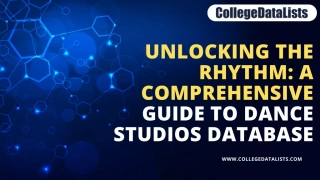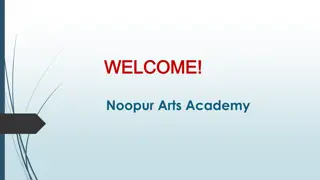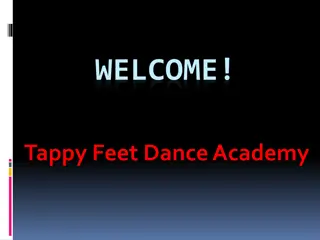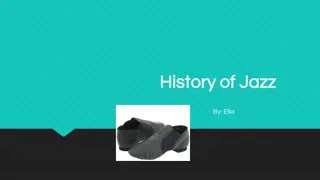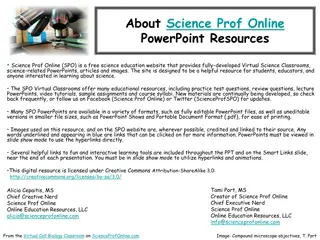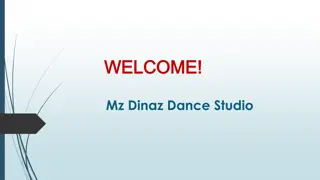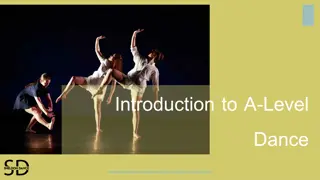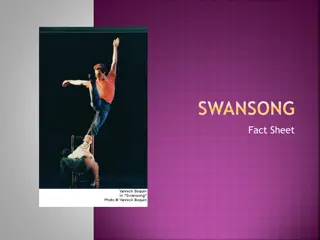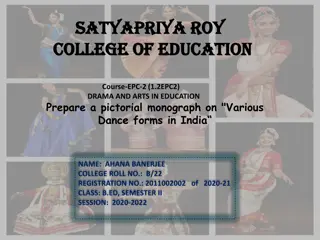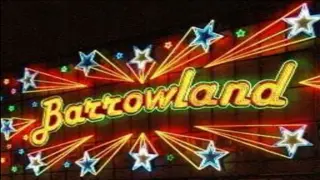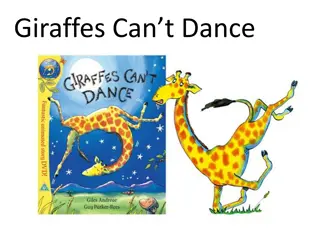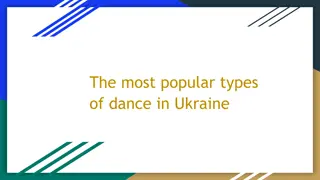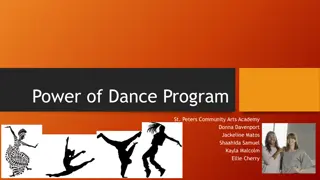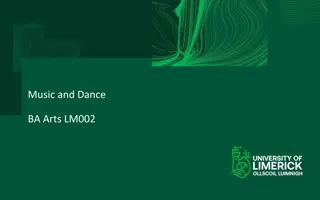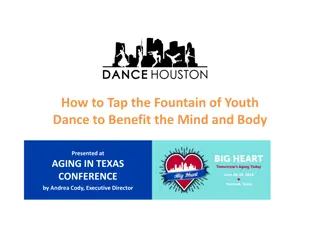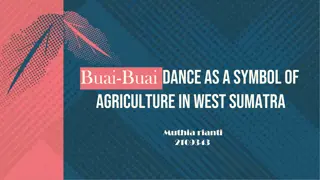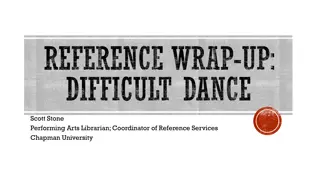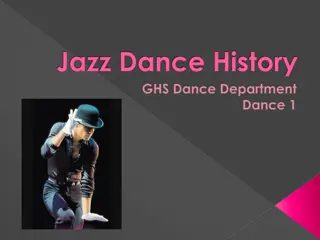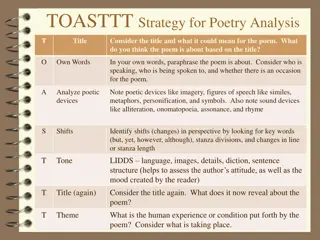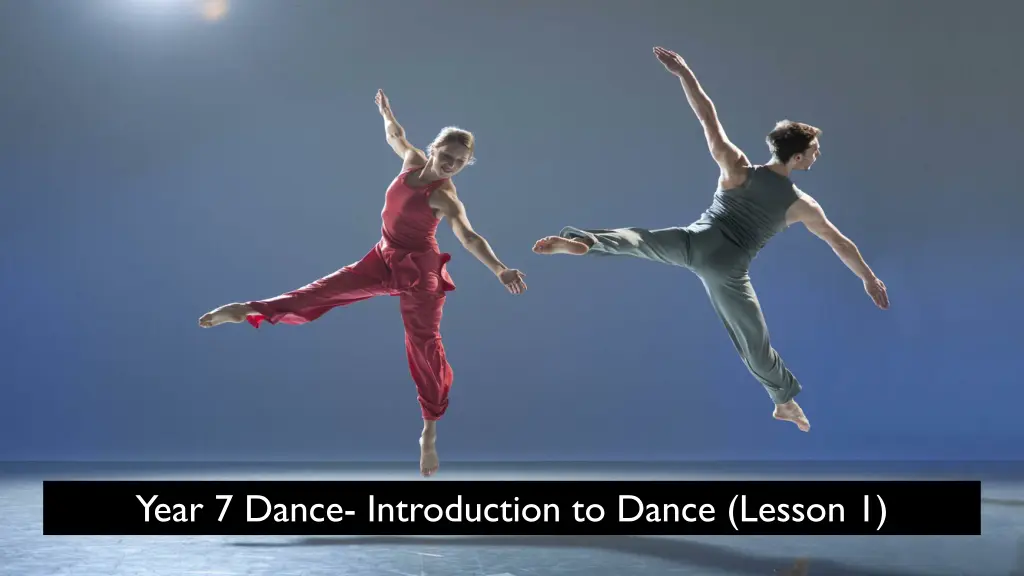
Dance Learning Journey for Year 7 Students
Dive into the world of dance with Year 7 students in an engaging learning journey. From prior experiences to discovering body actions, choreographic devices, and more, this program introduces students to different styles and elements of dance.
Download Presentation

Please find below an Image/Link to download the presentation.
The content on the website is provided AS IS for your information and personal use only. It may not be sold, licensed, or shared on other websites without obtaining consent from the author. If you encounter any issues during the download, it is possible that the publisher has removed the file from their server.
You are allowed to download the files provided on this website for personal or commercial use, subject to the condition that they are used lawfully. All files are the property of their respective owners.
The content on the website is provided AS IS for your information and personal use only. It may not be sold, licensed, or shared on other websites without obtaining consent from the author.
E N D
Presentation Transcript
In your booklet write down any experience you have had of dance before Did you have dance lessons at Primary School? Did you dance in a school performance? PRIOR LEARNING PHASE Do you have lessons outside of school- if so which styles? If you ve never danced before that s fine we ve had students who ve never danced before Year 7 who gain Distinction* in their GCSE (the highest grade!).
Hook phase: In your booklet can you write down the 5 body actions of dance (these were in your knowledge organisers!)? Your teacher may give you some clues! J T T G S
Hook phase: In your booklet can you write down the 5 body actions of dance (these were in your knowledge organisers!)? The Answers Jump Turn Travel Gesture Stillness Gesture: any movement without weight e.g. a kick of the leg Travel: any movement which transfers the dancer into another part of the space
Acquisition Phase: We are going to watch three dance videos. Can you complete the sections in your booklet? You need to: Write an example of each of the body actions of dance that you see e.g. Jump- the dancer performed a leap You can talk quietly once the video has been paused to give you time to share ideas to complete your tables. For those of you that want to complete the GOLD CHALLENGE can you find two examples of the actions? We will be watching: Overdrive by Richard Alston https://www.youtube.com/watch?v=4XnqJLBD4Lw&t=111s Swan Lake Black Swan Entree and Adage https://www.youtube.com/watch?v=p21n1xorjEs Cry me a River by Andrew Winghart https://www.youtube.com/watch?v=-I-SE6Q9Le0
Summary Phase: What is the name of the choreographic device used in Cry Me a River? What kinds of actions did we see? Overdrive by Richard Alston Swan Lake Black Swan Entree and Adage Cry me a River by Andrew Winghart Why do choreographers use a variety of actions in their work?
Prior Learning Phase: Answer these questions in your booklet What are the 5 body actions of dance? What is canon? Your teacher may give you some clues! J T T G S
Hook Phase: Formations What is a formation in football? Write your answer using a full sentence What do you think a formation would be in dance? A formation is where the dancers are positioned during the dance.
Acquisition Phase: Formations (One Flat Thing Reproduced) We are going to watch an extract from One Flat Thing Reproduced by William Forsythe. Why do the formations change in this dance? Clue: Why do we use a variety of body actions? One Flat Thing Reproduced (there is no sound) https://www.youtube.com/watch?v=SGvfqpQZC-s
Acquisition Phase: Formations (One Flat Thing Reproduced) Where is the best place to view formations in most dance works?
Struggle Phase: Creating your body action choreography In your booklet you are going to create your own choreography sequence. You should draw the action ideas that you have/ You need: 2 examples of different jumps 2 examples of different travelling movements 2 examples of different turns 2 examples of different gestures 2 examples of stillness Which two movements would work best in canon in a group dance? (You can use stick figures, it would also help to use arrows to show the direction of travel)
Prior Learning Phase: Answer these questions in your booklet If you were explaining the 5 body actions of dance to Year 6 how would you define each body action? J T T G S What does canon mean? What is a formation?
Hook Phase: Do you see all of the body actions in this dance? In your booklet write down the body actions you see. Are there any missing? Le Petit Bal Perdu https://www.youtube.com/watch?v=EJB2GtoP38Y
Acquisition Phase: Choreography at your table! With the person sitting next to you, you re going to explore how you can perform each body action of dance seated at your table. You can use any part of your upper body to complete each action. You should spend time exploring ideas and noting down the ones you think are effective. Jumps Turns Travels Stillness Gestures
Struggle Phase: Choreography at your table! Can you edit your best ideas and link them together to create a short sequence (this is what we would call a motif). Can you use two examples of each body action? Could you use any canon? Jumps Turns Travels Stillness Gestures
Prior Learning Phase: Choreography at your table! Can you draw out your choreography so that you can effectively rehearse it ready to perform today! Jumps Turns Travels Stillness Gestures
Elaboration Phase: Choreography at your table! We are going to watch each group perform their choreography. When you have completed yours take some time to watch other groups as well as completing these questions. What was effective in your choreography? What would you improve if you completed the choreography again? When watching other groups performing I thought the following was effective I think as a class we could have improved
Hook Phase: What is a stimulus? After watching the clip from Roadrunner what is a stimulus? Roadrunner Cartoon https://www.youtube.com/watch?v=qEozQLrZnPk&t=121s A stimulus is the trigger that inspires a choreographer to create a dance. It can be anything from a piece of music, to the way a piece of fabric moves in the wind. Choreographers create dances about anything and everything but they always begin with a stimulus!
Hook Phase: What is a stimulus? After watching the clip from Roadrunner what is a stimulus? Roadrunner Cartoon https://www.youtube.com/watch?v=qEozQLrZnPk&t=121s A stimulus is the trigger that inspires a choreographer to create a dance. It can be anything from a piece of music, to the way a piece of fabric moves in the wind. Choreographers create dances about anything and everything but they always begin with a stimulus!
Acquisition Phase: Still Life at The Penguin Cafe Still life at The Penguin Caf was choreographed by David Bintley in 1988. Bintley was inspired by a Vinyl record (this even predates your teachers!!!) by the Penguin Caf Orchestra. The cover featured anthropomorphic images showing half human, half animal combinations. On finding a book called the Domesday Book of Animals (which detailed extinct animals) Bintley was inspired to create a dance which takes place at The Penguin Caf , a place where penguins are waiters and the extinct or endangered creatures are performing.
Acquisition Phase: Still Life at The Penguin Cafe In your booklet how are the stimuli of Still Life presented in the opening section of the dance? Penguin Cafe play until end of penguin section Dance movements take place at different heights or levels what could the names of the levels be? H M L High Medium Low
Struggle Phase: Analysing the Texan Kangaroo Rat As we watch try and answer the questions in your booklet. There will be some completion time at the end of the clip Texan Kangaroo Rat https://www.youtube.com/watch?v=-Q1Pvjggl5A&t=181s
Struggle Phase: Analysing the Texan Kangaroo Rat (Answers) What actions did we see? Leg kicks, knee slaps, jumps, rolls (you will have written lots more!) What dynamics are the majority of movements performed with? The majority of the movements are performed with quick and sharp dynamics. This denotes the speed at which the rat moves. There is a springy quality to the movements to show that he is a jumping rat. What levels are used and how do these help to tell the story? All levels are used. The use of levels helps us to see that the rat is waking up at the start of his day. Following lots of jumping he becomes tired and we see him retreating back to the lower level to sleep. How do the movement dynamics help us to understand the character of the rat? There is no right or wrong here so as long as you ve given a reason it is a valid idea! How does the use of lighting help us to understand the story? The lighting shows the dawn and sunrising so that we know the rat is waking up. As he progresses through his day the lighting becomes brighter, become dull towards the end of the section as the sun sets. What pathway does the rat perform most of his movements using? The rat uses a circular pathway for most of the dance.
The Southern Cape Zebra The Southern Cape Zebra https://www.youtube.com/watch?v=Jh0TPvus7r4 Hook Phase: Watch the dance After your first viewing what do you think this section is about? Give reasons to support your ideas.
Acquisition Phase: The Southern Cape Zebra As we watch the section again can you describe the actions you see? How does the use of costume help you to understand the dance? The costume helps to show that the dancer is portraying the role of a zebra. The choreography is also very clear because of the tight fitting nature of the costume.
Struggle Phase: The Southern Cape Zebra Who are the women in the dance and what do they represent? The female dancers represent models. They are walking and posing throughout the dance. They are wearing zebra printed skirts to reference animals being killed for use in fashion/ clothing.
Struggle Phase: The Southern Cape Zebra Do you think that watching this section will encourage people to treat animals with respect? Make notes on the discussions you have below.
Struggle Phase: The Southern Cape Zebra Can you choreograph your own model choreography section? Can you make it funny? Remember to think about formations and perhaps your poses could change levels?
Humboldts Hog Nosed Skunk Flea: Assessment The video will be played three times, following each viewing complete the below questions: Viewing 1: Complete Question 1 Viewing 2: Complete Questions 2- 4 Viewing 3: Complete Question 5-7

